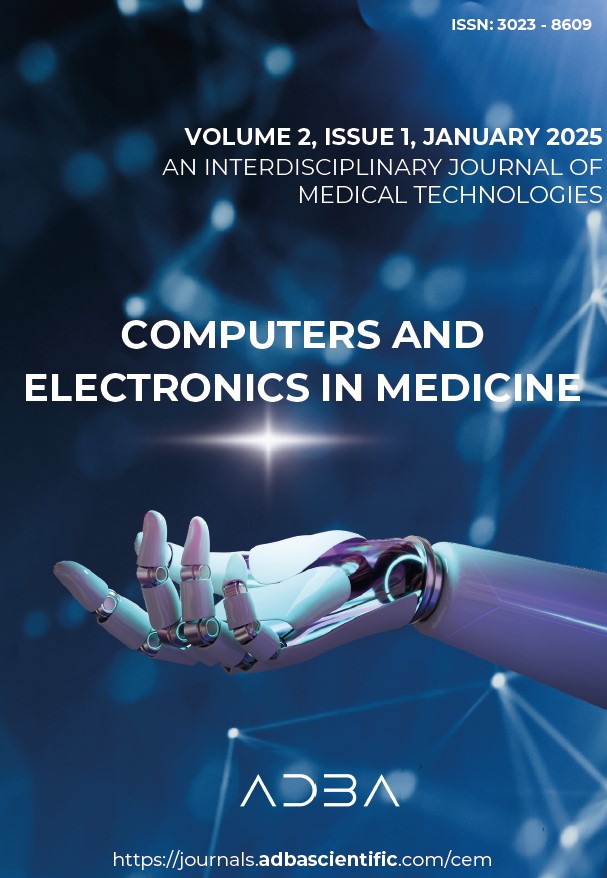Abstract
Artificial intelligence has emerged as a transformative tool in medical imaging, enabling automated diagnosis and analysis across various domains. While significant advancements have been made in abdominal imaging, many studies struggle to achieve robust detection of diseases. The complexity and variability in abdominal structures present unique challenges for traditional machine learning models, necessitating the adoption of more advanced object detection frameworks. Motivated by these challenges, this study focuses on leveraging the YOLOv9 object detection architecture to enhance the identification of abdominal diseases using the TEKNOFEST 2022 Abdomen Dataset. Advanced preprocessing techniques, including CLAHE (Contrast Limited Adaptive Histogram Equalization) and Gaussian noise augmentation, were applied to improve image contrast and model robustness. The dataset was processed into YOLO-compatible formats, and multiple training configurations were evaluated using YOLOv9c and YOLOv9s variants. These configurations included variations in batch size, optimizer type (SGD and Adam), dropout rate, and frozen layers. Among the configurations tested, the YOLOv9s model with 32 batch size, SGD optimizer, and a 35% dropout rate demonstrated the best performance, achieving a Recall of 0.7698, Accuracy of 0.7698, and F1 Score of 0.8228. The highest mAP50 of 0.9385 was observed with the YOLOv9c model trained using the Adam optimizer and a 35% dropout rate. Confusion matrix analysis revealed strong detection capabilities for conditions like acute cholecystitis and abdominal aortic aneurysm. This study highlights the potential of YOLOv9 models in medical imaging and emphasizes the importance of high-resolution datasets and advanced feature extraction techniques for improving diagnostic accuracy in abdominal disease detection. These findings lay a foundation for the development of reliable and efficient AI-driven diagnostic tools.
References
Boyraz, O. F., E. Guleryuz, A. Akgul, M. Z. Yildiz, H. E. Kiran, et al., 2022 A novel security and authentication method for infrared medical image with discrete time chaotic systems. Optik 267: 169717.
Chen, S., P. Wei, G. Wang, F. Wu, and J. Zou, 2025 Construction of a prognostic signature based on t-helper 17 cells differentiation–related genes for predicting survival and tumor microenvironment in head and neck squamous cell carcinoma. Medicine 104: e41273.
Donovan, S. M., M. Abrahams, J. C. Anthony, R. Bergia, G. Blander, et al., 2025 Perspective: challenges for personalized nutrition in the current US regulatory framework and future opportunities. Advances in Nutrition.
El-Tanani, M., S. A. Rabbani, S. M. Satyam, I. R. Rangraze, A. F. Wali, et al., 2025 Deciphering the role of cancer stem cells: Drivers of tumor evolution, therapeutic resistance, and precision medicine strategies. Cancers 17: 382.
Jin, J., Q. Zhang, B. Dong, T. Ma, X. Mei, et al., 2022 Automatic detection of early gastric cancer in endoscopy based on mask region-based convolutional neural networks (mask r-cnn)(with video). Frontiers in Oncology 12: 927868.
Koç, U., E. A. Sezer, Y. A. Özkaya, Y. Yarbay, M. S. Beşler, et al., 2024 Elevating healthcare through artificial intelligence: analyzing the abdominal emergencies data set (tr_abdomen_rad_emergency) at teknofest-2022. European Radiology 34: 3588–3597.
Koçer, S., O. Mohamed, and Ö. Dündar, 2024 Disease detection in abdominal ct images using the yolov5 algorithm: A deep learning approach. In 2024 59th International Scientific Conference on Information, Communication and Energy Systems and Technologies (ICEST), pp. 1–4, IEEE.
Liu, Z., H. Peng, Z. Ye, C. Lian, H. Shen, et al., 2025 Highly-efficient differentiation of reactive lymphocytes in peripheral blood using multi-object detection network with large kernels. Microscopy Research and Technique.
Maity, R., V. Raja Sankari, S. Umapathy, R. NA, and A. L. Salvador, 2024 Explainable ai based automated segmentation and multistage classification of gastroesophageal reflux using machine learning techniques. Biomedical Physics & Engineering Express.
Pisano, E. D., S. Zong, B. M. Hemminger, M. DeLuca, R. E. Johnston, et al., 1998 Contrast limited adaptive histogram equalization image processing to improve the detection of simulated spiculations in dense mammograms. Journal of Digital Imaging 11: 193–200.
Ramamoorthy, M., R. GnanaJeyaraman, C. M. B. MJ, A. Manimaran, K. N. Kannan, et al., 2024 Early cancer diagnosis and ulcer classifications in endoscopy videos using deep learning approach. In 2024 IEEE 6th Symposium on Computers & Informatics (ISCI), pp. 258–263, IEEE.
Ren, X., S. Chu, G. Ji, Z. Zhao, J. Zhao, et al., 2025 Omsf2: optimizing multi-scale feature fusion learning for pneumoconiosis staging diagnosis through data specificity augmentation. Complex & Intelligent Systems 11: 109.
Santos, L. L. A., M. C. de Azevedo, L. K. Shimamura, A. A. Nogueira, F. J. Candido-dos Reis, et al., 2024 Machine learning as a clinical decision support tool for diagnosing superficial peritoneal endometriosis in women with dysmenorrhea and acyclic pelvic pain. Medical Research Archives 12.
Shaikh, A., S. Amin, M. A. Zeb, A. Sulaiman, M. S. Al Reshan, et al., 2025 Enhanced brain tumor detection and segmentation using densely connected convolutional networks with stacking ensemble learning. Computers in Biology and Medicine 186: 109703.
Shujaat, S., 2025 Automated machine learning in dentistry: A narrative review of applications, challenges, and future directions. Diagnostics 15: 273.
Su, X., Q. Liu, X. Gao, and L. Ma, 2023 Evaluation of deep learning methods for early gastric cancer detection using gastroscopic images. Technology and Health Care 31: 313–322.
Tho, D. K. T., J. H. Lim, J.-S. Park, and S. Park, 2025 Deep learning-assisted diagnosis of extrahepatic common bile duct obstruction using mrcp imaging and clinical parameters. Current Medical Imaging p. e15734056363648.
Wang, C.-Y., I.-H. Yeh, and H.-Y. M. Liao, 2024 Yolov9: Learning what you want to learn using programmable gradient information.
Wang, S., Z.-A. Zhao, Y. Chen, Y.-J. Mao, and J. C.-W. Cheung, 2025 Enhancing thyroid nodule detection in ultrasound images: A novel yolov8 architecture with a c2fa module and optimized loss functions. Technologies 13: 28.
Zhou, Y., X. Tang, D. Zhang, and H. J. Lee, 2025 Machine learning empowered coherent raman imaging and analysis for biomedical applications. Communications Engineering 4: 1–14.

This work is licensed under a Creative Commons Attribution-NonCommercial 4.0 International License.

